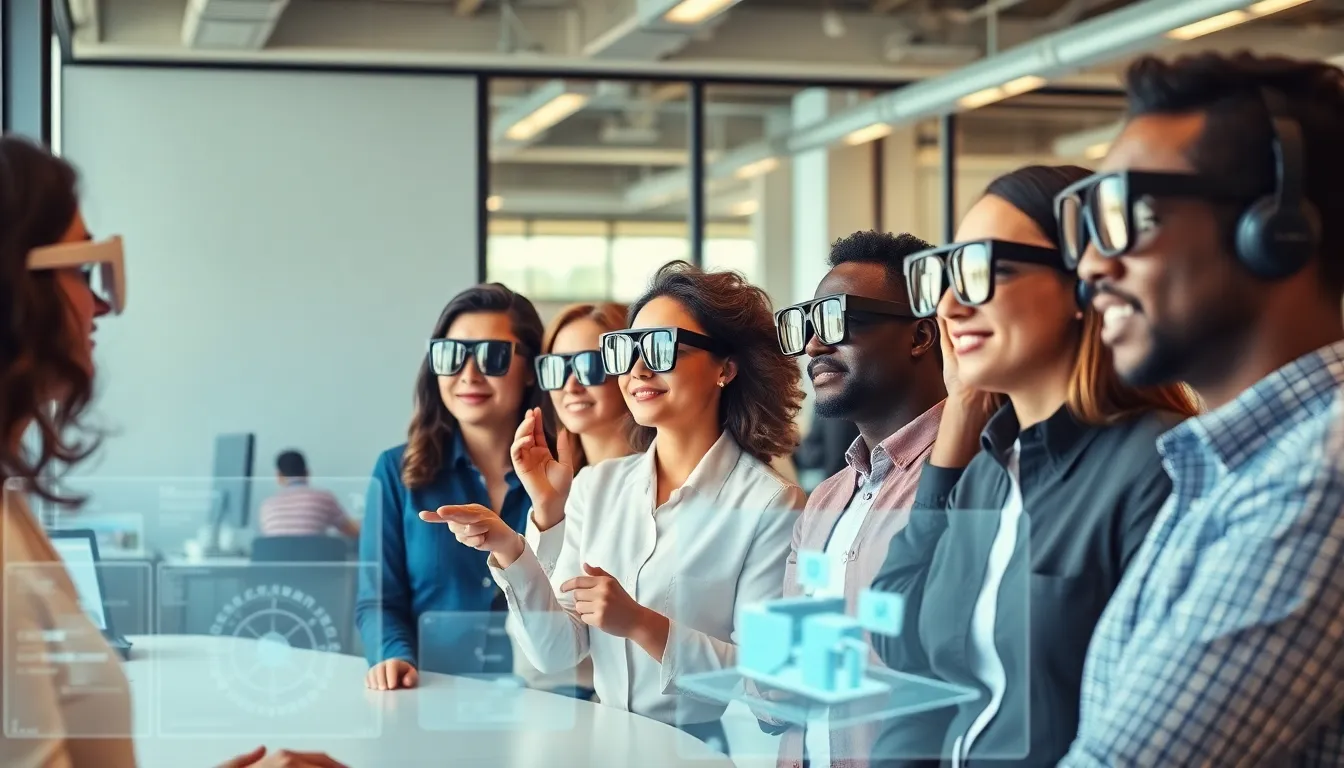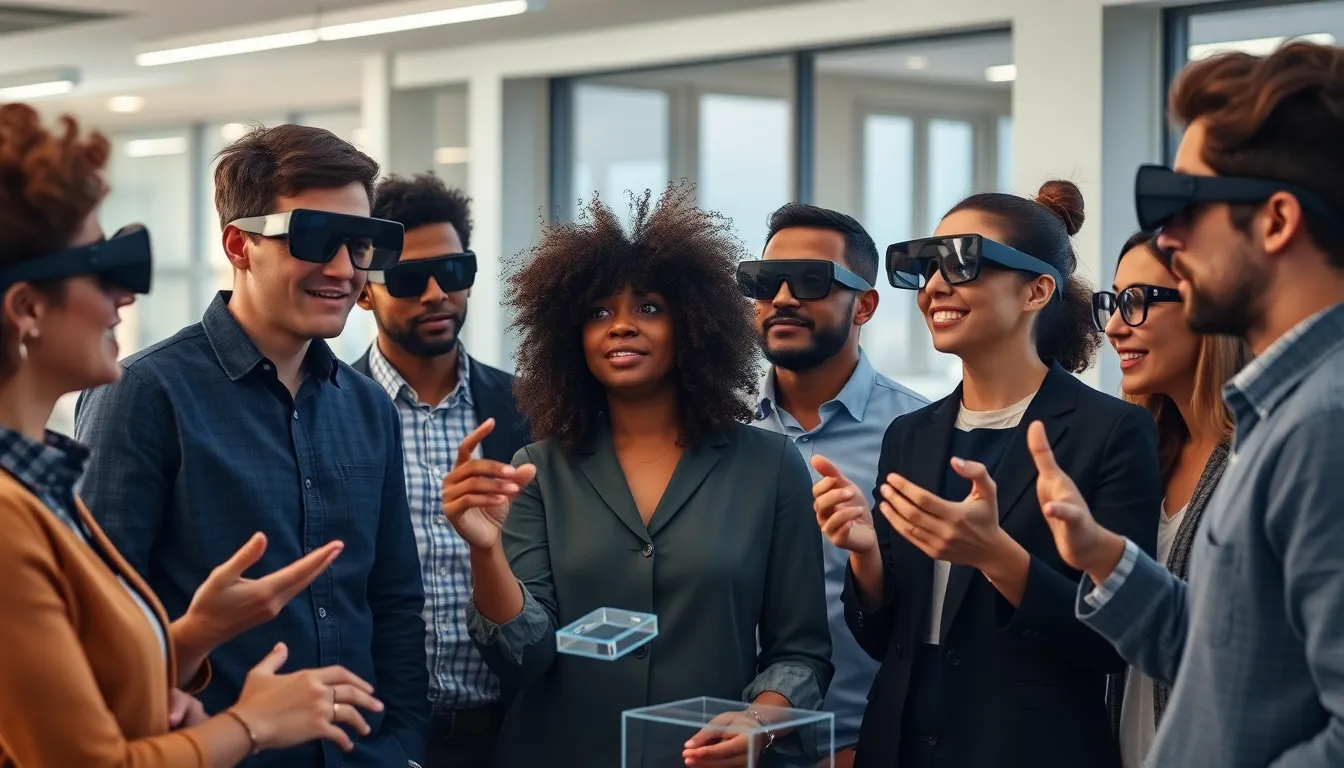Imagine walking through a world where digital and reality collide, creating experiences that make you question what’s real. That’s the magic of Augmented Reality (AR) industries, where innovation meets imagination. From gaming to healthcare, AR is reshaping how people interact with their environments, making mundane tasks feel like a scene from a sci-fi movie.
With AR, the future isn’t just bright; it’s downright dazzling. Picture this: a surgeon performing intricate procedures with virtual overlays guiding their every move or a shopper trying on clothes without stepping foot in a store. The possibilities are endless, and they’re evolving faster than you can say “Where’s my virtual assistant?” AR industries are not just a trend; they’re a revolution, and now’s the perfect time to dive into this fascinating world.
Table of Contents
ToggleOverview of AR Industries
Augmented Reality (AR) significantly alters how various sectors operate, merging digital data with reality to enhance user experiences. Healthcare sectors leverage AR for surgical procedures, allowing professionals to view critical information in real time. Retailers utilize AR to improve customer interaction, enabling shoppers to virtually try on apparel before buying.
Education also benefits from AR through immersive learning experiences, helping students visualize complex concepts. Marketing teams explore AR for interactive campaigns, drawing consumer attention in engaging ways. Manufacturing industries adopt AR for employee training, improving skill acquisition through real-world simulations.
Real estate agents present properties through virtual tours, allowing potential buyers to explore spaces without physical visits. The entertainment industry embraces AR for enhanced gaming experiences, making gameplay more immersive and interactive. Automotive manufacturers incorporate AR in design and assembly processes, streamlining operations and reducing errors.
Tourism employs AR to provide augmented experiences, enriching the information available to visitors. Military and defense sectors integrate AR for training simulations, enhancing preparedness without real-world consequences. Architecture firms visualize projects with AR technology, offering clients previews of proposed designs.
Various sectors continue to invest in AR technology, recognizing its potential to transform business operations and client interactions. The growth of AR industries reflects an increasing demand for innovative solutions that blend the digital and physical worlds. As the technology develops, its applications will likely expand, further impacting how industries operate and engage with their audiences.
Current Trends in AR Industries


Augmented Reality (AR) continues to reshape various industries, showcasing remarkable advancements. Its influence grows as sectors integrate AR into their operations, enhancing productivity and engagement.
Adoption Rates Across Sectors
Retail leads in AR adoption, with 61% of retailers implementing AR technology for virtual try-ons and product visualization. Healthcare follows closely, as 56% of medical professionals utilize AR for enhanced surgical precision. Education sees increased use, with 49% of institutions employing AR for immersive learning experiences. Advertising and marketing sectors leverage AR campaigns, with 42% of businesses reporting successful interactive promotions. Manufacturing also rises, with 39% of companies adopting AR for worker training and operational efficiency. These statistics demonstrate a clear trend toward widespread acceptance of AR technology across diverse fields.
Key Innovations and Technologies
Innovations in AR technology drive its adoption forward. Real-time data visualization becomes essential, as 3D overlays assist professionals in various tasks. Mobile integration enhances accessibility, allowing users to engage with AR through smartphones and tablets. Smart glasses, like Microsoft HoloLens, revolutionize hands-free experiences, enabling professionals to interact seamlessly with digital content. Cloud computing improves collaboration as users access and share AR experiences from different locations. Additionally, machine learning algorithms enhance AR applications, tailoring experiences to user preferences and behaviors. These technological advancements solidify AR’s role in modern business practices.
Impact of AR Industries on Various Fields
Augmented Reality (AR) continues to reshape various sectors, driving innovative solutions that blend the physical and digital realms.
Healthcare Applications
AR enhances surgical precision by providing surgeons with real-time overlays of critical patient data. Surgeons can visualize complex anatomy during procedures, which leads to improved outcomes. Medical training also benefits, as students interact with 3D models of human anatomy, fostering a deeper understanding of intricate concepts. Current statistics show that 56% of healthcare providers are actively investing in AR technologies, reflecting a strong trend toward integrating advanced tools in medical practice.
Education and Training
Interactive learning experiences offered through AR engage students more effectively. Educators utilize AR applications to bring abstract concepts to life, making lessons more memorable. For instance, students can explore historical events or scientific phenomena in an immersive setting, enhancing retention. With 49% of educational institutions implementing AR, it becomes clear that this technology significantly impacts how knowledge is delivered and absorbed.
Retail Transformation
Retailers leverage AR to revolutionize shopping experiences by enabling virtual try-ons for clothing and accessories. Shoppers can visualize products in their environment before making a purchase, resulting in increased satisfaction. Personalized marketing campaigns featuring AR lead to greater customer engagement, proving effective in driving sales. Statistics indicate that 61% of retailers are adopting AR, highlighting its crucial role in enhancing customer interaction and streamlining the purchase process.
Challenges Facing AR Industries
AR industries face multiple challenges that may hinder their growth and innovation. Addressing these challenges is essential for maximizing AR’s potential.
Technical Limitations
Technical limitations significantly impact AR adoption across sectors. Issues such as latency can disrupt real-time interactions, reducing the effectiveness of applications. Hardware constraints also play a role, as many devices lack the processing power to support advanced AR experiences. Furthermore, inconsistencies in software compatibility create hurdles, stalling development and deployment. As AR technology matures, overcoming these limitations is crucial for enhancing user experiences and fostering widespread acceptance.
Market Competition
Market competition presents another challenge for AR industries. Numerous firms are vying for dominance, with innovations emerging rapidly. Retailers, healthcare providers, and educational institutions all seek to leverage AR, intensifying competition. Differentiating products and services from competitors becomes vital for companies striving for market share. As retail leads AR adoption with 61% of retailers using the technology, maintaining a competitive edge requires continuous innovation and strategic partnerships. Without clear positioning, companies risk becoming overshadowed in a crowded marketplace.
Future Outlook for AR Industries
Growth prospects for AR industries appear robust as advancements continue. Projections indicate that the AR market may reach $198 billion by 2025, driven by increased user engagement and the demand for interactive experiences. Retail remains at the forefront, with 61% of retailers adopting AR technologies to enhance customer interactions. Healthcare follows closely behind, with 56% of providers actively investing in AR for improved surgical outcomes and training enhancements.
Innovations in real-time data visualization play a pivotal role in accelerating AR’s integration across sectors. Mobile integration facilitates convenient access to AR experiences, allowing users to engage with content whenever needed. Smart glasses are becoming more prominent, offering hands-free interaction while minimizing distractions. Cloud computing supports data storage and processing for more complex AR applications.
Machine learning algorithms improve AR interactions by personalizing experiences according to user behavior. As these technologies evolve, they contribute to more seamless integrations in areas like construction and tourism. In fact, architecture firms leverage AR to improve project visualization for clients, enhancing decision-making processes.
Despite this positive outlook, challenges persist. Technical limitations such as latency and hardware constraints slow AR adoption. Software compatibility issues hinder the development of cohesive solutions, creating barriers for smaller companies. Market competition intensifies as more enterprises seek to carve out their niche.
Collaborative endeavors become crucial for success in this rapidly evolving landscape. Strategic partnerships among technology providers and industry leaders may enhance innovation. As AR continues to reshape sectors like education, marketing, and entertainment, ongoing investment in research and development remains vital for sustained growth and advancement.
Overall, the momentum for AR industries is undeniable, with its trajectory pointing toward further integration into everyday business practices and consumer interactions.
The future of AR industries is bright and full of potential. As technology continues to evolve businesses across various sectors are recognizing the immense benefits of integrating augmented reality into their operations. This innovative approach not only enhances user experiences but also streamlines processes and improves outcomes.
With significant investments pouring into AR applications the momentum is building. The ongoing advancements in real-time data visualization and mobile integration are set to redefine how industries interact with consumers. As AR becomes more accessible and user-friendly the possibilities for its application are virtually limitless.
Embracing this technology will be crucial for organizations aiming to stay competitive in an ever-changing landscape. The journey of AR has only just begun and its impact will undoubtedly shape the future of numerous industries.



